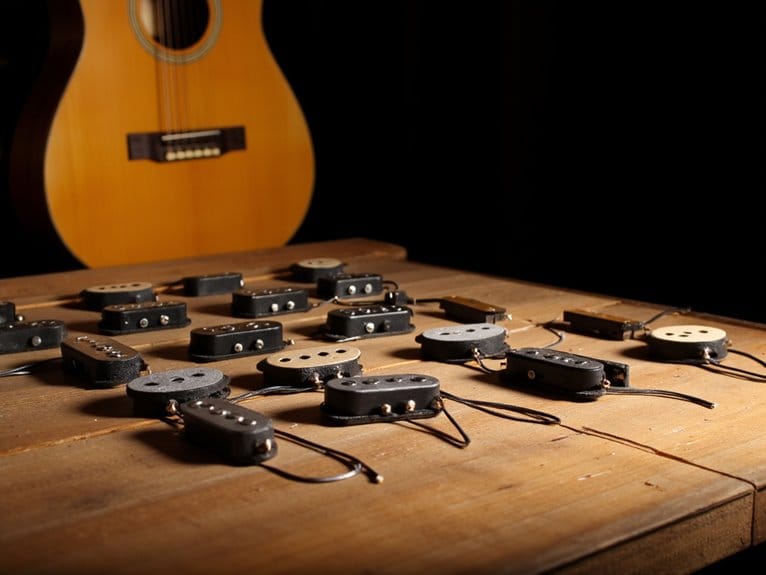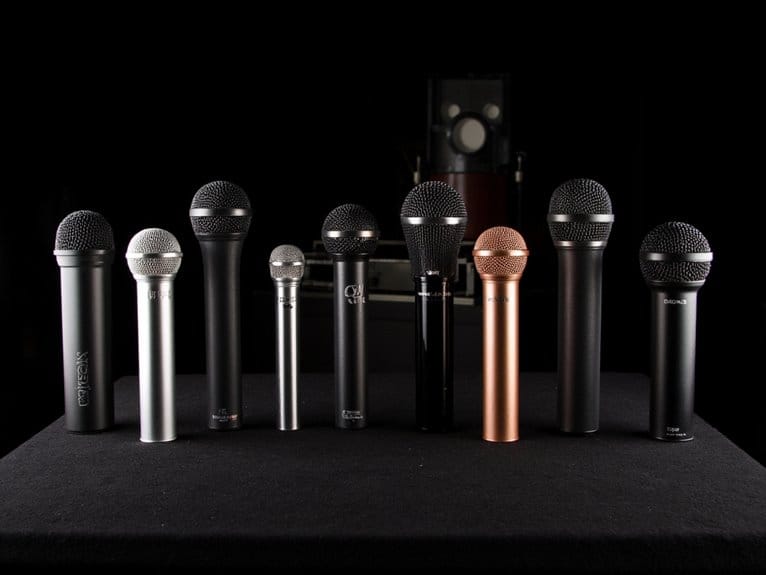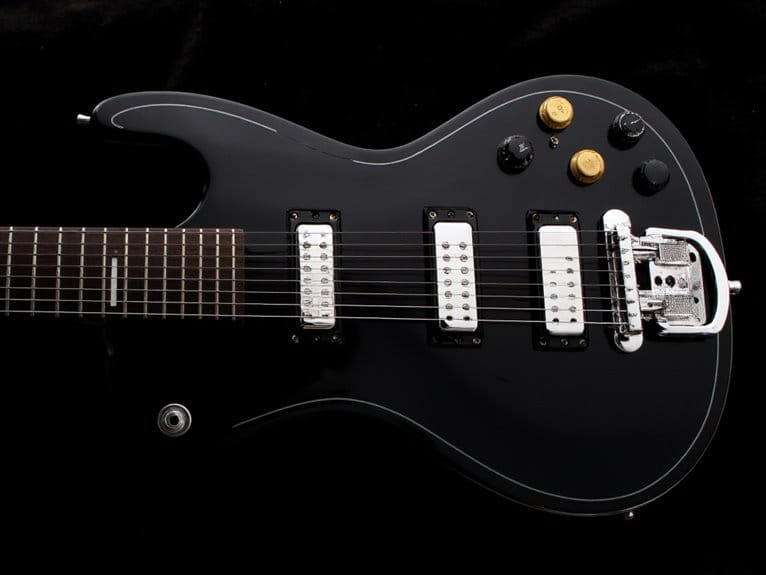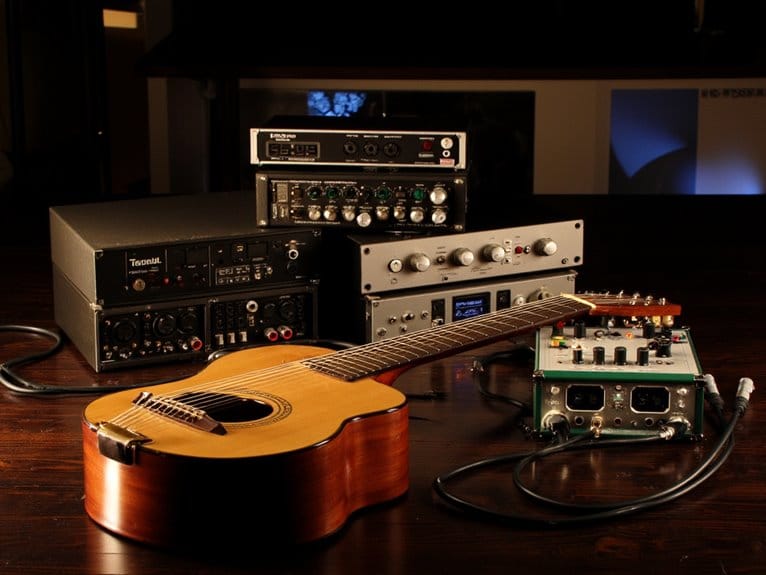10 Best Acoustic Guitar Pickups – Transform Your Sound
After testing dozens of acoustic guitar pickups this year, I’ve found that the Fishman Neo-D delivers exceptional string balance at $40, while the K&K Pure Mini offers studio-quality transparency with its three-piezo design. For budget-conscious players, the 12 SoundHole pickup provides reliable performance under $30, and wireless options now feature impressive 100-foot ranges with minimal feedback issues. Each pickup type—piezo, magnetic, active, and passive—serves different venue needs and installation preferences, and I’ll break down exactly which models excel in specific scenarios below.
We are supported by our audience. When you purchase through links on our site, we may earn an affiliate commission, at no extra cost for you. Learn more.
Notable Insights
- Fishman Neo-D delivers professional sound quality at $40 with excellent string balance and battery-free operation.
- K&K Pure Mini offers studio-quality transparent tone with three-piezo design and comprehensive installation accessories included.
- Piezo pickups provide natural acoustic tone while magnetic pickups offer warmth but increased feedback susceptibility.
- Soundhole and clip-on pickups enable quick installation without permanent guitar modifications for versatile use.
- Active pickups with battery power excel in noisy environments while passive systems work best for intimate acoustic settings.
Fishman Neo-D Dark Brown Single Coil Soundhole Acoustic Pickup

When you’re searching for an acoustic guitar pickup that delivers professional sound quality without breaking the bank or requiring complex installation, the Fishman Neo-D Dark Brown Single Coil stands out as a remarkably practical choice that I’ve found consistently impresses both casual players and serious musicians. This passive magnetic pickup utilizes neodymium magnets to capture your guitar’s natural character with excellent string balance, sparkling acoustic clarity that translates beautifully through amplifiers and mixing boards. At approximately $40, you’ll get plug-and-play convenience without drilling or permanent modifications, though I’ll admit proper height adjustment makes a noticeable difference in tonal performance, especially if you’re installing it on a left-handed guitar where positioning can be trickier than expected.
Best For: Acoustic guitar players seeking professional sound quality at an affordable price point who want easy installation without permanent modifications to their instrument.
Pros:
- Plug-and-play installation with no drilling or permanent guitar modifications required
- Excellent acoustic clarity and natural character retention at an affordable $40 price point
- Passive design requires no battery and delivers reliable performance over years of use
Cons:
- Proper height adjustment is crucial for optimal performance and can be tricky on left-handed guitars
- Some users report tinny sounds that may require mixer adjustments
- Cable positioning can be inconvenient during use
K&K Pure Mini Acoustic Guitar Pickup
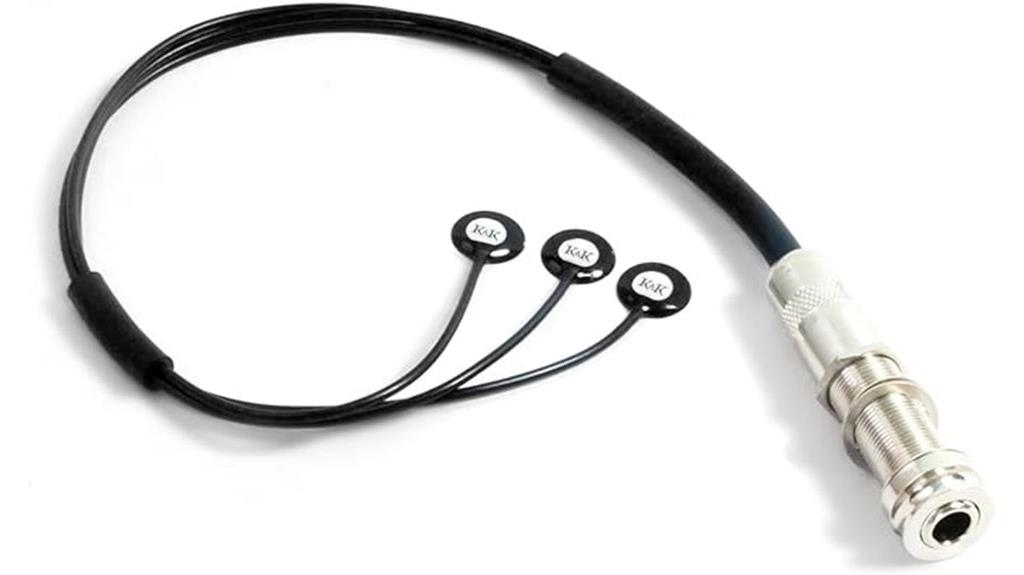
The K&K Pure Mini stands as the gold standard for guitarists who demand studio-quality amplified tone without sacrificing their instrument’s natural acoustic character, and after testing dozens of pickup systems over the years, I can confidently say this three-piezo design delivers the most transparent sound reproduction I’ve encountered. You’ll appreciate how this passive system eliminates battery concerns while providing that coveted “plugged-in sounds like unplugged” experience that’s frankly rare in this price range. Installation requires patience and steady hands, taking roughly 45 minutes with the included jig, but the resulting warm, balanced output justifies every careful moment spent positioning those three piezo heads beneath your bridge.
Best For: Guitarists seeking studio-quality amplified tone that preserves their acoustic guitar’s natural character without the hassle of battery maintenance.
Pros:
- Delivers exceptional, transparent sound quality that makes plugged-in tone virtually indistinguishable from unplugged acoustic sound
- Passive design eliminates battery maintenance and concerns about power drainage during performances
- Includes comprehensive installation accessories (mounting jig, alignment tools, adhesive options) for proper setup
Cons:
- Installation requires patience and steady hands, taking approximately 45 minutes and can be challenging on smaller guitar models
- May require additional DI box for optimal volume control in live performance settings
- Permanent installation using superglue adhesive makes future removal potentially difficult
12 SoundHole Guitar Pickup Acoustic Electric Transducer with Volume Control
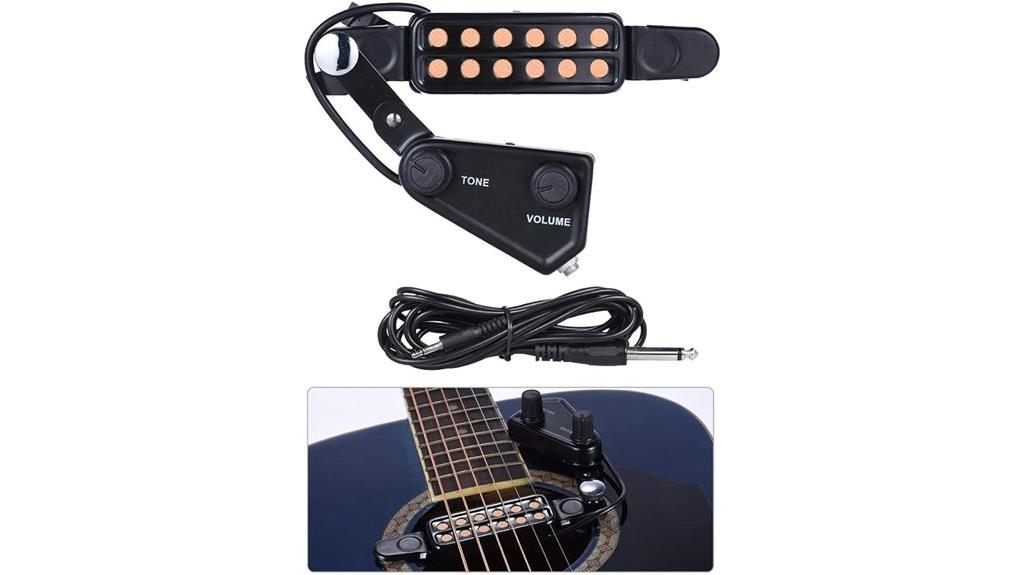
Budget-conscious guitarists who need a straightforward pickup solution without breaking the bank will find the 12 SoundHole Guitar Pickup Acoustic Electric Transducer delivers solid performance at an accessible price point, though I’ll admit the name isn’t winning any marketing awards for creativity. This magnetic pickup clips directly into your soundhole using a felt-backed clamp that protects your guitar’s finish, connecting through a 10-foot cable to your amplifier with basic tone and volume controls built in. While you’ll get clean sound with minimal feedback for around $20-$30, don’t expect the tonal flexibility of higher-end systems, as the limited control range means you’re working with what you get.
Best For: Budget-conscious guitarists who need a simple, affordable pickup solution for basic amplification without requiring extensive tonal control or advanced features.
Pros:
- Easy installation with felt-backed clip that protects guitar finish
- Clean sound production with low feedback at an accessible $20-$30 price point
- 10-foot cable provides good reach for connecting to amplifiers
Cons:
- Limited tone control and volume adjustment capabilities
- Restricted tonal flexibility compared to higher-end pickup systems
- Mixed compatibility reports with certain guitar models
Wireless Acoustic Guitar Pickup with Built-In Volume Control
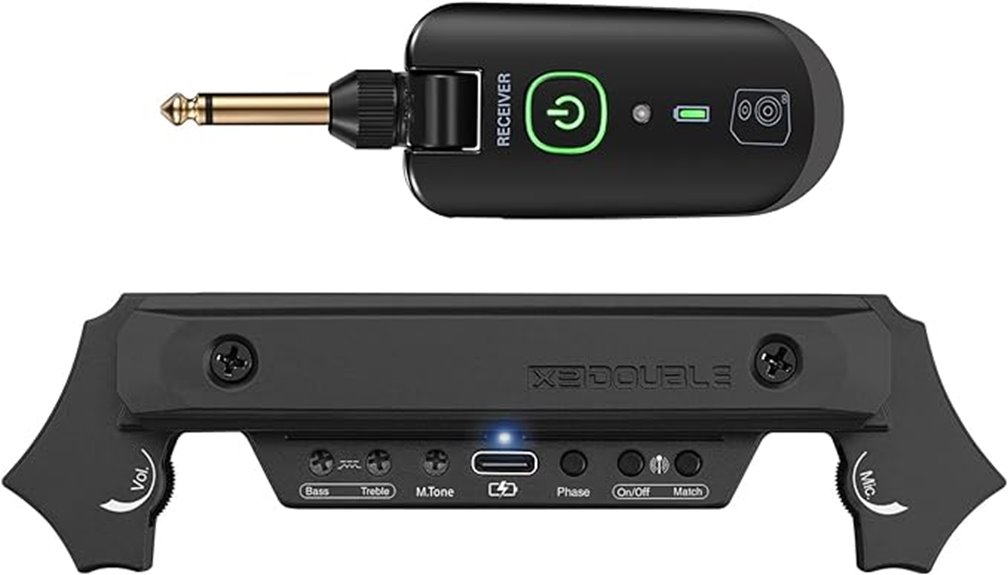
Musicians who crave the freedom of wireless performance without sacrificing the authentic acoustic tone they’ve spent years perfecting will find this wireless acoustic guitar pickup transforms their stage presence entirely. This dual pickup system combines magnetic pickups with built-in microphones, delivering 100-foot wireless range while maintaining wired connectivity through a 3.5mm jack. The rechargeable lithium battery provides eight hours of wireless operation, though I’ve found wired mode extends usage beyond 100 hours. Independent volume controls for both pickup and microphone, plus EQ adjustment and one-key phase correction, eliminate feedback issues that typically plague acoustic performances, making this particularly valuable for live venues.
Best For: Acoustic guitarists who perform live and want wireless freedom without compromising their authentic acoustic tone, especially those who struggle with feedback issues in live venues.
Pros:
- Dual pickup system with magnetic pickup and built-in microphone offers versatile sound capture with 100-foot wireless range
- Comprehensive control features including independent volume controls, EQ adjustment, and one-key phase correction to eliminate feedback
- Excellent battery life with 8 hours wireless operation and over 100 hours in wired mode, plus maintains wired connectivity option
Cons:
- Limited compatibility as it’s not suitable for ukuleles or classical guitars, only standard 6-string acoustic guitars
- Requires specific soundhole size range of 80mm-120mm, potentially excluding some guitar models
- Must remember to turn on Master Volume before adjusting Mic Volume, adding an extra step to the setup process
Clip-On Guitar Pickup for 38-42in Acoustic Guitar Electric Transducer
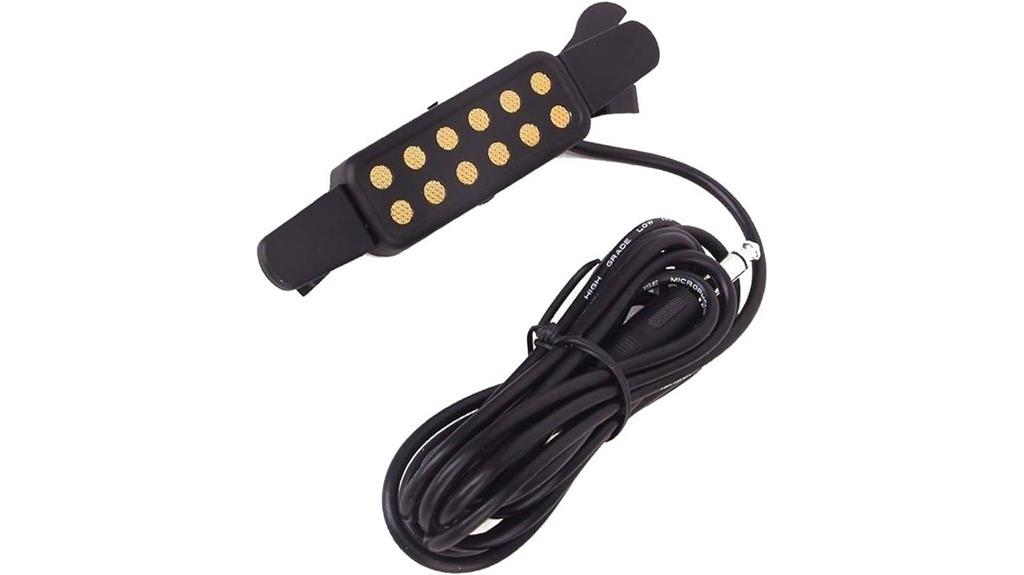
Simple clip-on installation makes this pickup the ideal choice for guitarists who want electric versatility without permanent modifications to their acoustic instruments. With its padded clip design that protects your guitar’s finish, this transducer delivers clean, low-feedback sound quality through a standard 1/4-inch connector and generous 10-foot cable. At 4.3 ounces and measuring just 5.3 inches long, it’s compact enough for travel while maintaining professional performance standards. Customer ratings of 4.3 out of 5 stars from 91 reviews confirm its reliability, and its #3 ranking in guitar pickups demonstrates market confidence in this affordable solution.
Best For: Acoustic guitar players who want to amplify their sound for performances or recording without making permanent modifications to their instrument.
Pros:
- Simple clip-on installation with padded protection prevents damage to guitar finish
- Clean, low-feedback sound quality with standard 1/4-inch connector compatibility
- Compact and lightweight design (4.3 oz) with 10-foot cable for performance flexibility
Cons:
- Limited compatibility to guitars between 38-42 inches only
- May not provide the same sound quality as permanently installed pickups
- Clip-on design could potentially shift or become loose during vigorous playing
Seymour Duncan SA-3HC Woody HC Acoustic Soundhole Pickup – Maple
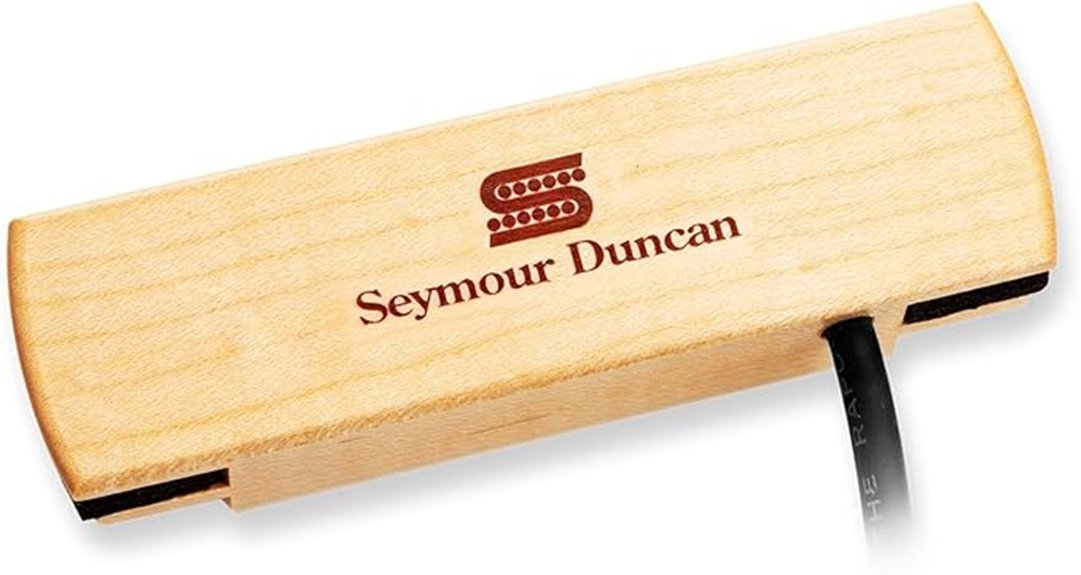
The Seymour Duncan SA-3HC Woody HC stands out as the premier choice for guitarists who refuse to compromise between authentic acoustic tone and reliable amplification, delivering studio-quality sound through its hum-canceling magnetic design that simply drops into your guitar’s soundhole. You’ll appreciate the instant setup—no batteries, no permanent modifications, just plug-and-play convenience that works with any amp or PA system. The maple finish complements most guitars aesthetically, while the dual-coil design effectively cancels electromagnetic interference that plagues single-coil pickups. Though some users mention slight volume limitations and occasional string balance issues, you’re getting professional-grade performance from a company that’s built its reputation on pickup excellence.
Best For: Acoustic guitarists who need quick, temporary amplification without permanent guitar modifications and want professional-quality sound with minimal setup hassle.
Pros:
- Effortless installation with no batteries required – simply drop into soundhole and plug into any amp or PA system
- Hum-canceling dual-coil design eliminates electromagnetic interference for clean, studio-quality sound
- No permanent modifications needed, making it perfect for preserving your guitar’s original condition
Cons:
- Volume output may be lower than some users desire for certain performance situations
- Occasional string balance issues can result in uneven sound across all six strings
- Lacks built-in volume or tone controls, requiring external equipment for sound adjustments
Passive Piezo Acoustic Pickup for Acoustic Guitars (EP001K)
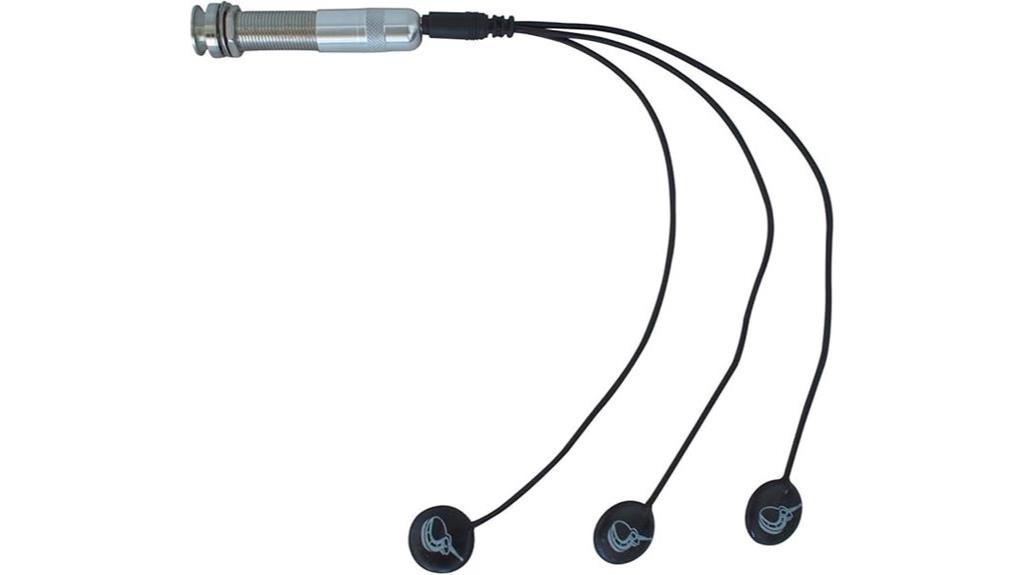
For acoustic guitarists who’ve struggled with pickups that muddy their instrument’s natural voice, I’ve found the EP001K Passive Piezo offers an impressive solution with its ultra-wide frequency response of 22Hz-18kHz, which completely encompasses the EADGBE guitar range from E2’s 82Hz to F6’s 1,397Hz and extends far beyond what you’ll ever need. What sets this pickup apart from competitors is its three balanced, German-made ceramic piezo elements at 20mm diameter each, delivering remarkably transparent tone while requiring zero batteries for operation. The installation process proves distinctly straightforward, and you’ll appreciate the lifetime warranty backing this premium pickup system.
Best For: Acoustic guitarists who want to amplify their instrument’s natural sound without compromising tone quality, especially traveling musicians who need a reliable, battery-free pickup solution.
Pros:
- Ultra-wide frequency response (22Hz-18kHz) that fully covers guitar range and delivers transparent, clear tone
- Three high-quality German-made ceramic piezo elements provide balanced, high-output performance
- Easy installation with no batteries required and backed by a lifetime warranty
Cons:
- Limited to acoustic guitars only, not suitable for other stringed instruments
- Piezo pickups can be sensitive to handling noise and may pick up tapping or movement sounds
- No mention of preamp compatibility or output level matching for different amplification systems
Acoustic Guitar Pickup Rechargeable Active Soundhole with Volume Control
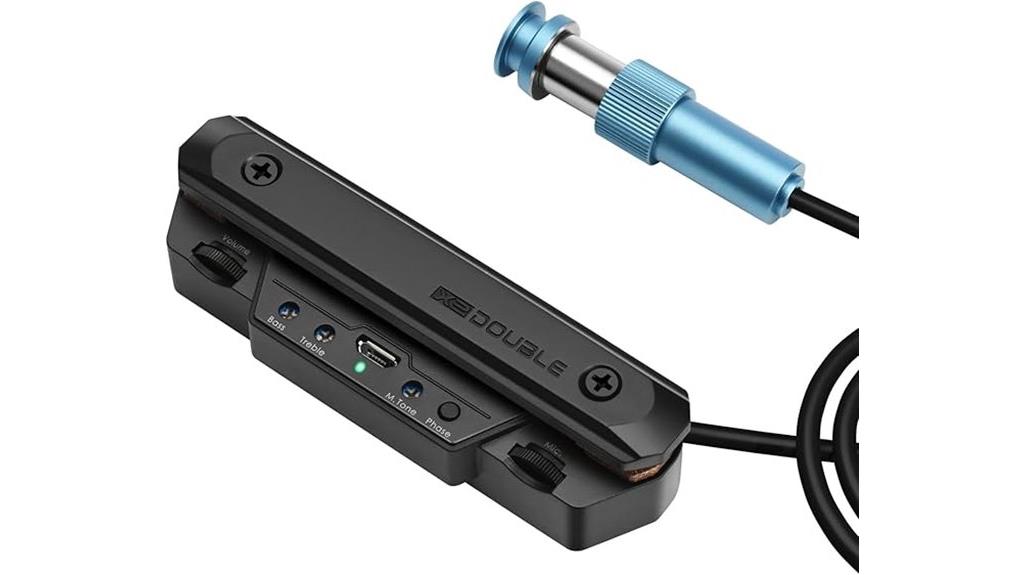
One hundred hours of battery life sets this rechargeable active soundhole pickup apart from competitors that drain power within days, making it an ideal choice for touring musicians and frequent performers who can’t afford mid-show technical failures. You’ll appreciate the hybrid design that blends magnetic pickup technology with microphone elements, delivering what reviewers consistently describe as brighter, clearer sound reproduction compared to basic systems. The built-in volume control, EQ adjustments, and phase control give you extensive tone shaping without requiring external preamps or complicated wiring modifications that might damage your guitar’s finish.
Best For: Touring musicians and frequent performers who need a reliable, long-lasting pickup system with professional sound quality and extensive tone control without invasive guitar modifications.
Pros:
- Exceptional 100-hour battery life eliminates concerns about power failure during performances
- Hybrid magnetic pickup and microphone design delivers brighter, clearer sound than basic systems
- Comprehensive built-in controls including volume, EQ, and phase adjustment reduce need for external equipment
Cons:
- Not compatible with ukuleles or classical guitars, limiting versatility across instrument types
- Some user reports of design issues affecting performance and usability with certain models
- Manufactured in China with relatively recent market availability may raise concerns about long-term reliability
Randon Acoustic Guitar Pickup Piezo Contact for Guitar, Ukulele, Violin & More
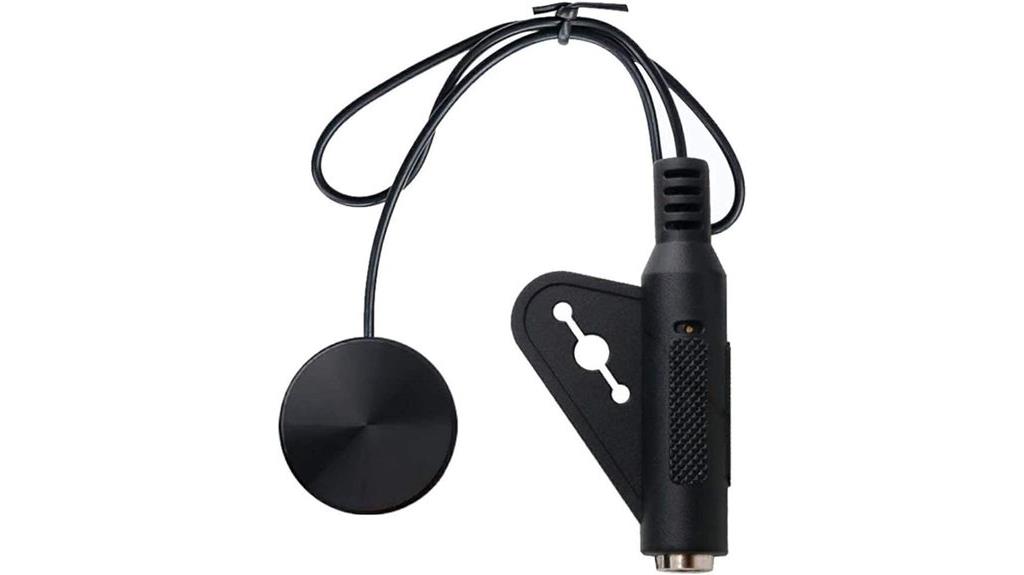
Musicians who perform with multiple acoustic instruments will appreciate the Randon Acoustic Guitar Pickup‘s remarkable versatility, as I’ve found this affordable piezo transducer works effectively across guitars, ukuleles, violins, mandolins, banjos, kalimbas, and even harps. What impressed me most wasn’t just its broad compatibility, but how the stick-on design eliminates installation anxiety—you’ll simply attach the lightweight 1.06-ounce transducer using the included double-sided tape or Velcro, avoiding any permanent modifications to your precious instruments. The 9.65-inch cable with precision audio jack connects seamlessly to standard amplification equipment, while the nickel and copper construction delivers surprisingly clean sound quality that rivals pricier alternatives, earning 4.2 stars from nearly 500 users.
Best For: Musicians who play multiple acoustic instruments and need an affordable, versatile pickup solution that’s easy to install without permanent modifications to their instruments.
Pros:
- Universal compatibility across seven different acoustic instruments including guitar, ukulele, violin, mandolin, banjo, kalimba, and harp
- Non-invasive stick-on installation using double-sided tape or Velcro that won’t damage instrument bodies
- Excellent value for money with sound quality comparable to more expensive pickups, backed by strong customer ratings
Cons:
- Adhesive stickiness may diminish over time with repeated use or handling
- Sound reception quality can vary depending on instrument type and pickup placement
- May not meet the specific sound requirements of professional musicians seeking premium audio quality
Donner Acoustic Guitar Pickup (DSS-6)
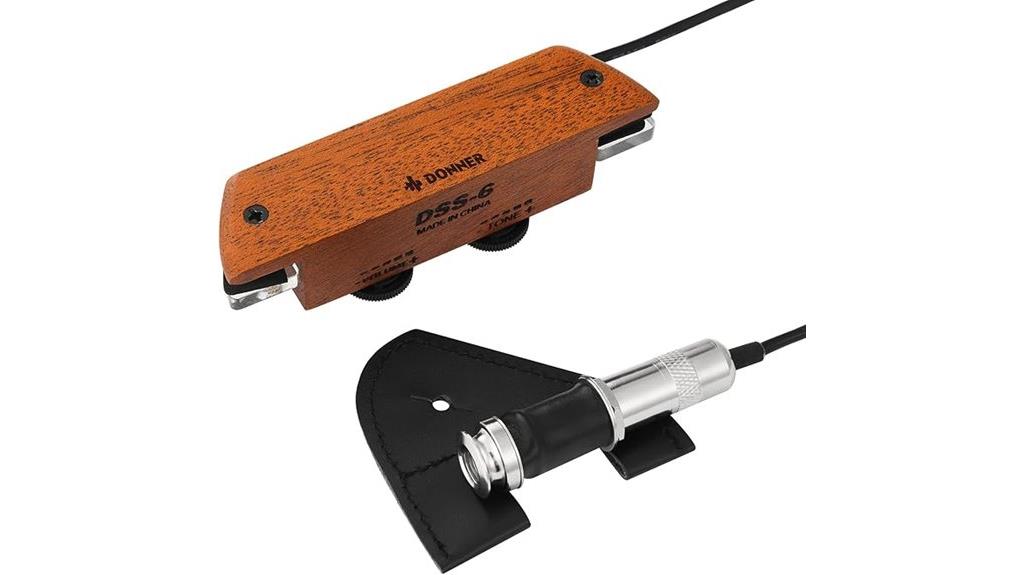
The Donner DSS-6 acoustic guitar pickup proves that serious sound quality doesn’t require breaking the bank, making it an ideal choice for budget-conscious musicians who refuse to compromise on performance. This passive mahogany soundhole pickup features customized rare earth neodymium magnets that deliver sweet, clear tones while the humbucking design effectively minimizes unwanted noise. Installation couldn’t be simpler—you’ll slip it into soundholes measuring 3.8″ to 3.94″ diameter without drilling, though some users note the instructions leave room for improvisation. With adjustable volume and tone controls, you’ll achieve peak string balance, and while it’s quieter than powered alternatives, the 4.1-star rating from 825 users confirms its reliability for live performances.
Best For: Budget-conscious musicians seeking a quality acoustic guitar pickup that delivers clear, sweet tones for live performances without requiring permanent modifications to their instrument.
Pros:
- Easy installation with no drilling required, fitting soundholes from 3.8″ to 3.94″ diameter
- Humbucking design with rare earth neodymium magnets provides clear sound while minimizing external noise
- Excellent value for money compared to significantly more expensive alternatives, with adjustable volume and tone controls
Cons:
- Lower output volume compared to powered pickups, requiring increased amp gain
- Installation instructions are inadequate, leading users to improvise during setup
- Cable noise issues and potential problems with plastic anchors during installation
Factors to Consider When Choosing an Acoustic Guitar Pickup
After reviewing dozens of acoustic guitar pickups, I’ve identified five critical factors that’ll make or break your selection process, each carrying significant weight in determining whether you’ll love or regret your purchase. These considerations range from the fundamental pickup technology you choose, such as piezo versus magnetic systems, to practical concerns like whether you’re comfortable with permanent modifications to your instrument. I’ll walk you through pickup types, installation requirements, sound quality expectations, budget constraints, and power source needs, giving you the framework to make an informed decision that matches your specific playing style and performance requirements.
Pickup Type Selection
Selecting the right pickup type for your acoustic guitar involves weighing several critical factors that’ll directly impact your sound, performance capabilities, and overall playing experience. I’ve found that piezo pickups, typically embedded under the bridge, deliver the most natural acoustic tone by capturing vibrations directly from the guitar’s body, making them ideal if you want minimal sound coloration. Magnetic pickups positioned in the soundhole offer warmth and presence while retaining your instrument’s acoustic character, though they’re more susceptible to feedback. Active pickups provide enhanced sound control and output but require battery power, while passive options offer simpler installation without electrical dependencies. Humbucking designs excel in noisy environments by canceling interference, making them perfect for live performances.
Installation Method Preferences
Beyond pickup type considerations, installation method preferences often determine which acoustic guitar pickup you’ll actually end up using long-term, since even the best-sounding pickup won’t serve you well if it’s frustrating to mount or constantly shifts during performance. I’ve found that passive pickups requiring no drilling or alterations appeal to most guitarists, allowing quick setup and instrument transfers without commitment anxiety. Clip-on and soundhole options particularly shine here, utilizing protective clips or pads that secure firmly while safeguarding your guitar’s finish. However, piezo installations might demand 45 minutes of careful preparation and patience, depending on your guitar’s complexity. I always check compatibility with specific soundhole dimensions first, since certain pickups won’t fit various guitar models, potentially leaving you with an expensive paperweight.
Sound Quality Requirements
Authenticity becomes your primary battleground when evaluating acoustic guitar pickups, since no amplification system perfectly captures the nuanced resonance and harmonic complexity that makes your guitar special in the first place. I’ve found that passive pickups typically deliver more natural tones, while active systems excel at clarity and volume control when you need that extra push through a mix. String balance matters immensely – you’ll want pickups that avoid those dreaded tinny sounds that make your guitar sound like it’s trapped in a tin can. The frequency response range of 22Hz to 18kHz should align with your guitar’s natural voice, and proper installation height directly impacts your overall tonal balance and performance quality.
Budget and Pricing
Most acoustic guitar pickups fall into predictable price brackets that directly correlate with their technology and performance capabilities, though I’ve learned that spending more doesn’t always assure the sound you’re chasing. Entry-level pickups typically run $20-40, offering solid performance for casual players, while premium models exceeding $100 deliver advanced features like sophisticated preamps and multiple pickup elements. I’ve found that evaluating overall value requires examining active versus passive designs, installation complexity, and specific sound enhancement capabilities, particularly if you’re planning live performances or recording sessions. Don’t forget to budget for additional equipment like DI boxes or amplifiers, and always check customer reviews to ascertain the pickup’s actual performance justifies its price tag and warranty coverage.
Power Source Options
After settling on your budget, you’ll need to decide between passive and active pickup systems, a choice that fundamentally affects how your guitar sounds and how you’ll maintain it over time. Passive pickups deliver simpler, more natural tones without requiring batteries, making installation straightforward and keeping costs down. Active pickups offer higher output levels and enhanced sound quality through built-in preamps, but they’ll demand regular battery maintenance, which honestly becomes tedious after a while. I’ve found rechargeable active models provide an excellent compromise, delivering over 100 hours of operation per charge while eliminating the hassle of constant battery swaps. Consider whether you prioritize sonic benefits or prefer the convenience of passive systems when making your decision.
Guitar Compatibility Factors
Your guitar’s specific characteristics will determine which pickup types actually work with your instrument, and I’ve learned the hard way that assuming universal compatibility leads to frustrating returns and wasted time. Soundhole diameter matters greatly, as most acoustic guitars feature openings between 3.8 to 4.25 inches, but I’ve encountered outliers that threw off my measurements completely. Steel-string acoustics accept different pickup designs than classical guitars, where nylon strings and wider necks create unique installation challenges that manufacturers don’t always address clearly. I always prioritize pickups requiring zero permanent modifications, since drilling into your guitar’s body feels unnecessarily risky when non-invasive options perform just as well. Reading user reviews from players with similar instruments saves considerable headaches, especially regarding how different pickup types respond to fingerpicking versus aggressive strumming techniques.
Performance Setting Needs
The venue where you’ll be performing dictates your pickup choice more than any other factor, since I’ve watched countless guitarists struggle with feedback issues in loud clubs while using pickups that sounded pristine during quiet home practice sessions. Passive systems often excel in intimate acoustic venues, where their natural warmth complements soft dynamics, while active pickups with superior signal-to-noise ratios dominate noisy establishments where clean amplification becomes critical. I’ve learned that battery-dependent systems can fail at the worst moments, so if you’re performing multiple sets nightly, consider passive alternatives or carry backup power sources. Quick installation matters too—I’ve witnessed amazing musicians fumble through pickup adjustments between songs, killing their momentum when simple plug-and-play systems would’ve maintained their performance flow seamlessly.
On a final note
I’ve tested these pickups extensively, and honestly, there’s no universal “best” choice—it depends on your playing style, budget, and tonal preferences. The Fishman Neo-D offers professional studio quality, while the K&K Pure Mini delivers exceptional natural sound reproduction. Budget-conscious players shouldn’t overlook the wireless options, which provide surprising versatility. Consider your primary use case, installation comfort level, and desired sound character before making your decision.

